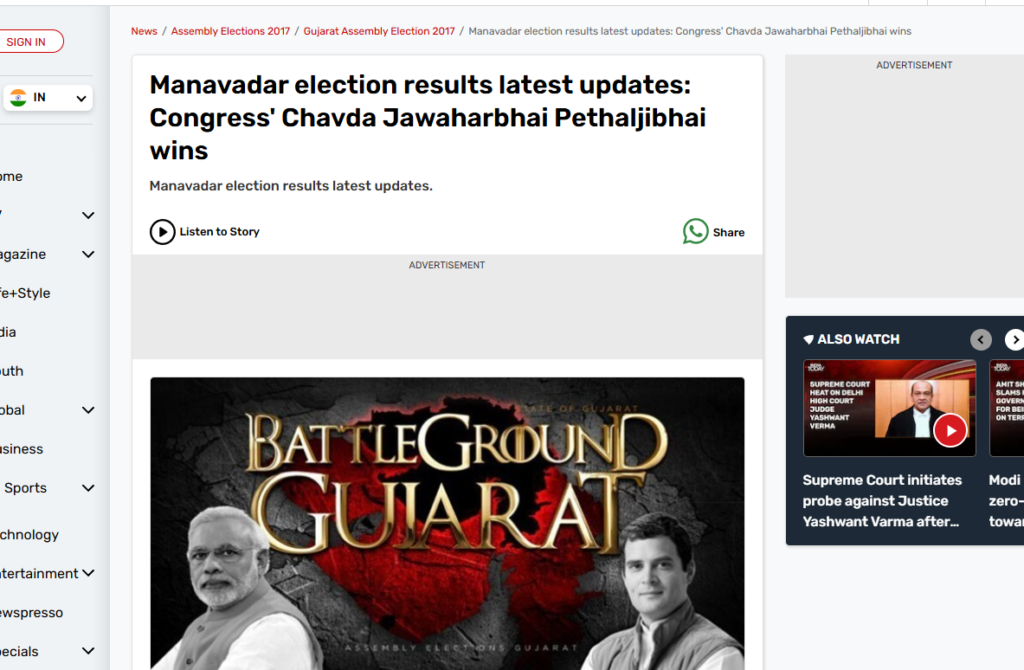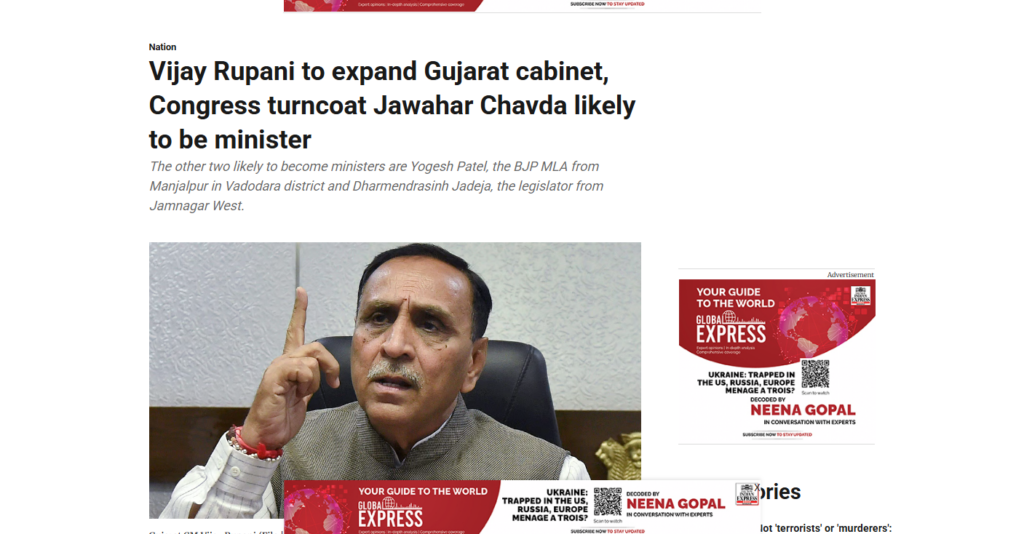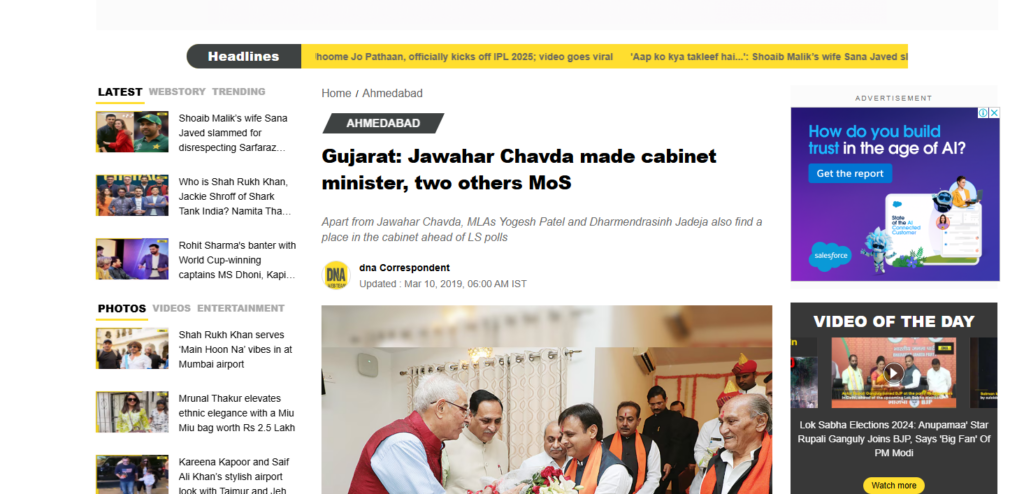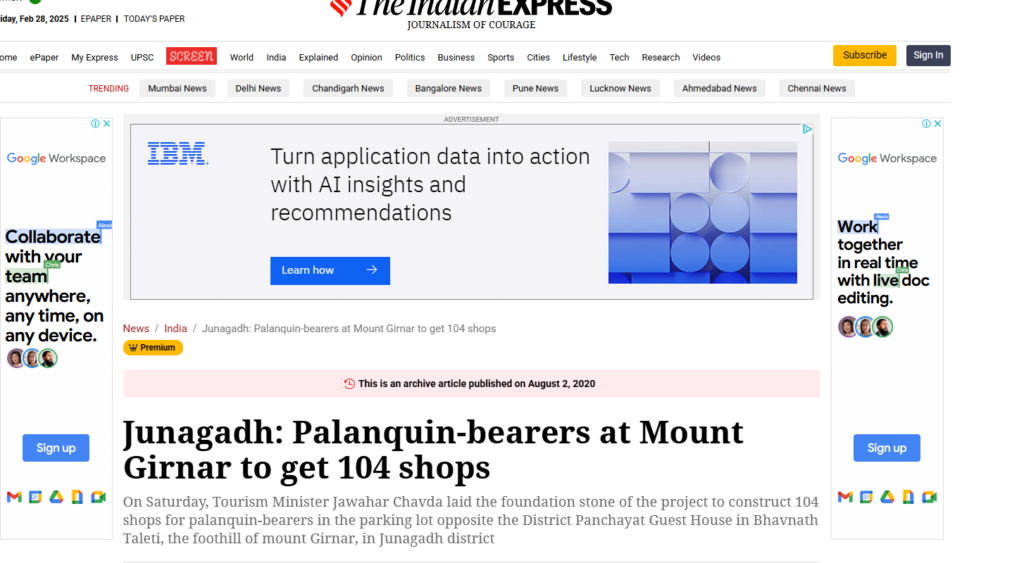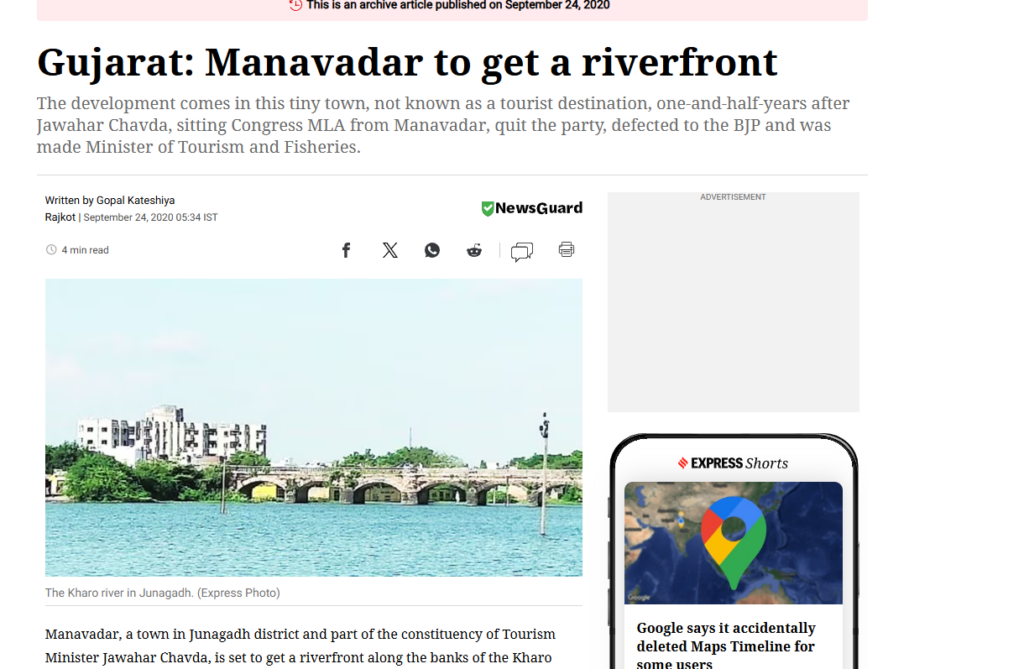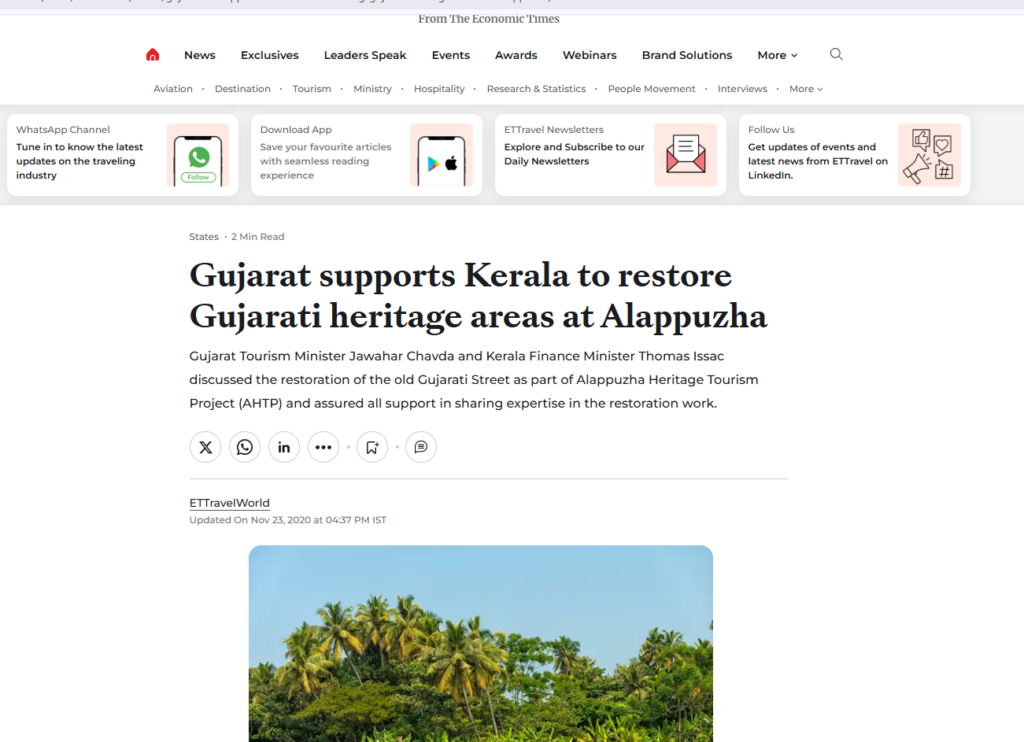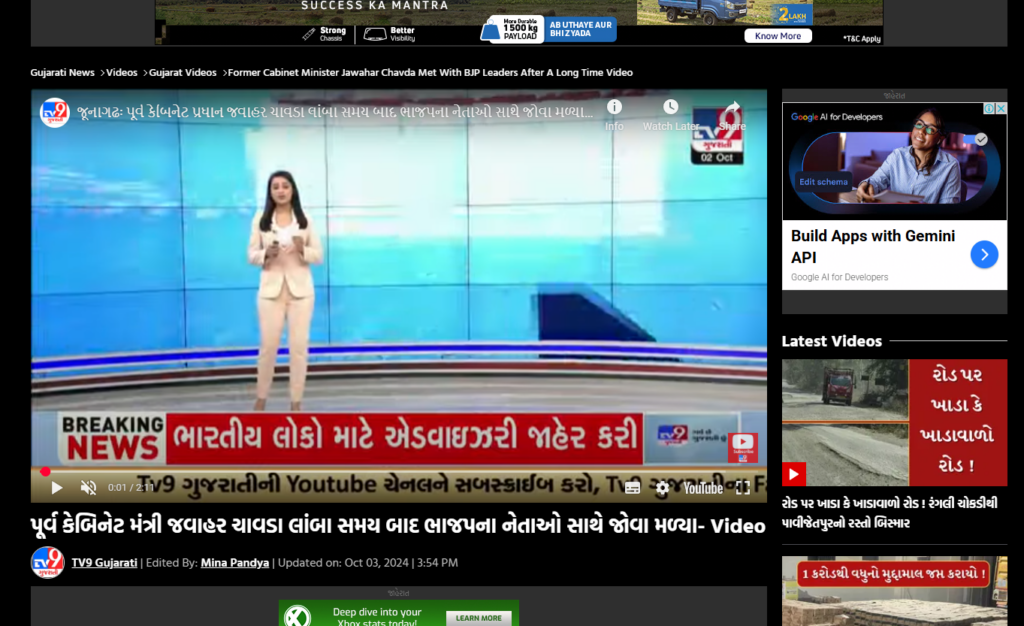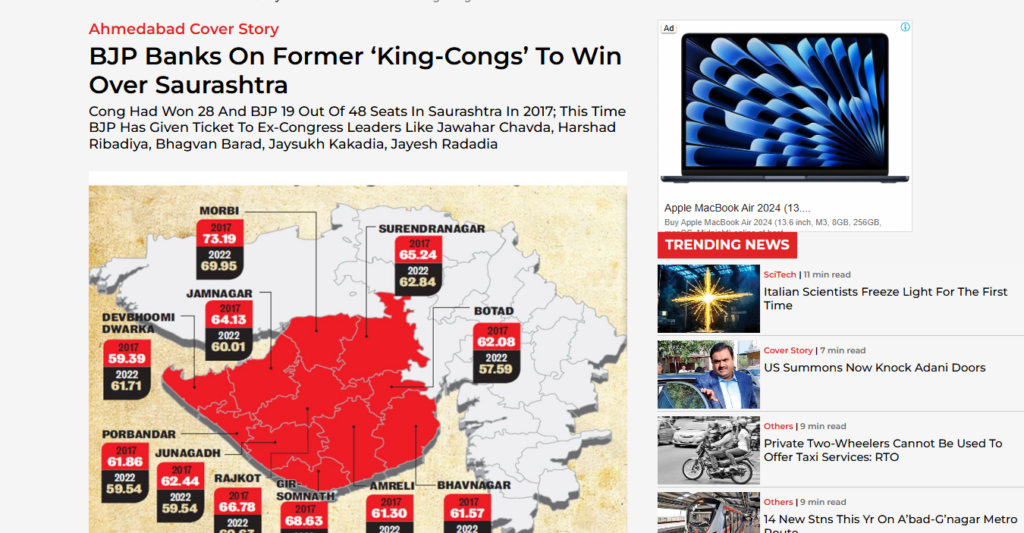
Timeline
At 25, Jawahar Chavda achieved a breakthrough by winning his first MLA election, defeating veteran Jerambhai Patel (Janta Dal & BJP – President). His victory stemmed from his father’s strong reputation, Congress Party support, and effective grassroots mobilization. Overcoming an initial 25,000-vote deficit, he secured a decisive win, marking a shift in voter sentiment. This success established him as a key opposition leader in Gujarat’s BJP-dominated political landscape, launching his influential political career.
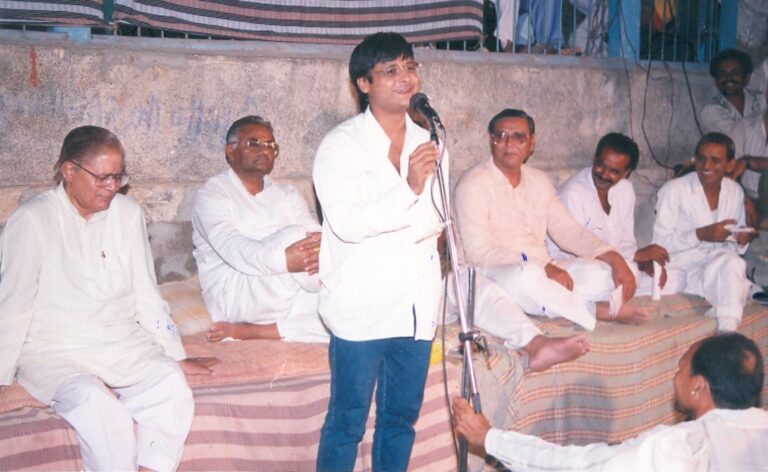
In 2000, Jawahar Chavda showcased his grassroots strength by winning the Tehsils Panchayat elections with an independent panel. Rejecting major party affiliations, he built a dedicated team focused on local governance. His campaign emphasized direct voter engagement and community issues, leading to a decisive victory—securing 9 out of 15 Taluka Panchayat seats and a District Panchayat seat, reaffirming his deep public trust and political resilience.
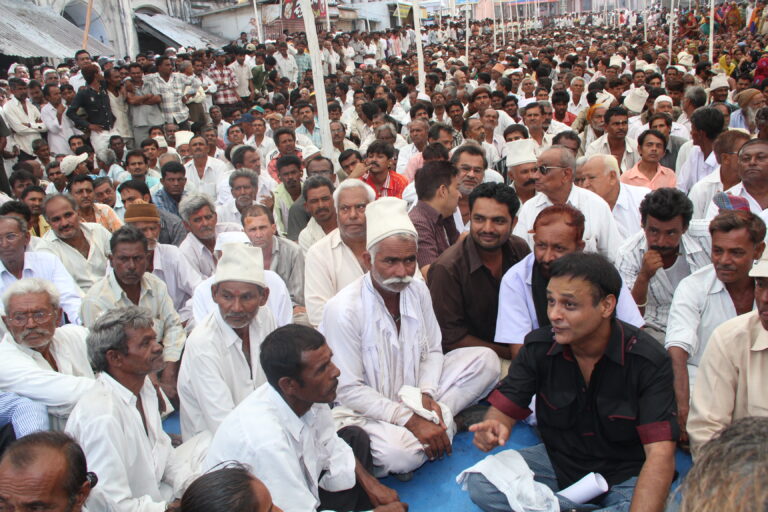
In 2007, running as a Congress candidate, Jawahar Chavda made a strong political comeback by winning the MLA election. His victory was significant, as he triumphed over an unfamiliar opponent, reaffirming his leadership and public support in the constituency.

From 2007 to 2019, Jawahar Chavda’s political career was significantly defined by his unwavering advocacy for farmers’ rights. This period saw him consistently championing the cause of agricultural communities, particularly within his constituency. Recognizing the critical role farmers play in the region’s economy and the challenges they faced, he became a vocal advocate for their needs. His work extended beyond mere protest, encompassing detailed research, strategic planning, and persistent legislative action to bring about tangible changes in government policies. During this time, he also worked to reform crop insurance processes, and advocated for better flood management, ensuring farmers received fair compensation and protection from natural disasters. This dedication to farmers’ rights solidified his reputation as a leader deeply connected to the agricultural backbone of his community.
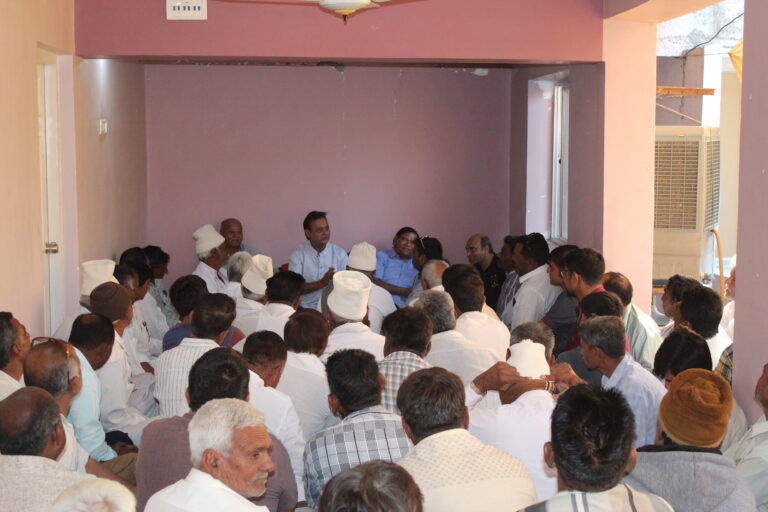
Jawahar Chavda played a pivotal role in securing development funds for Junagadh, initially ₹600 crore, later increased to ₹1100 crore. Despite government delays in disbursing the promised funds, Chavda mobilized public pressure and relentlessly advocated for their release. He emphasized the original commitment made by then-Chief Minister Narendra Modi and Finance Minister Vaju Vala, ensuring Junagadh received its rightful allocation. His persistent efforts paved the way for crucial regional development.
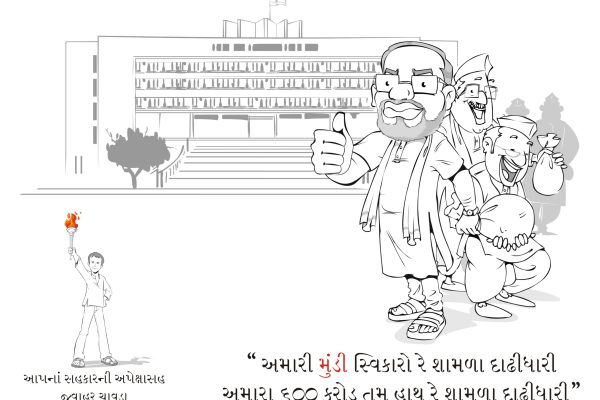
After a three-year struggle, Jawahar Chavda successfully overturned Gujarat’s Dark Zone Movement restrictions in 2012. The policy unfairly limited farmers’ access to water and electricity while allowing industries to extract groundwater. Through extensive advocacy, protests, and legislative challenges, he exposed this injustice. His persistence led the government to lift the restrictions, restoring farmers’ rights and proving that determined activism can overcome systemic inequities.
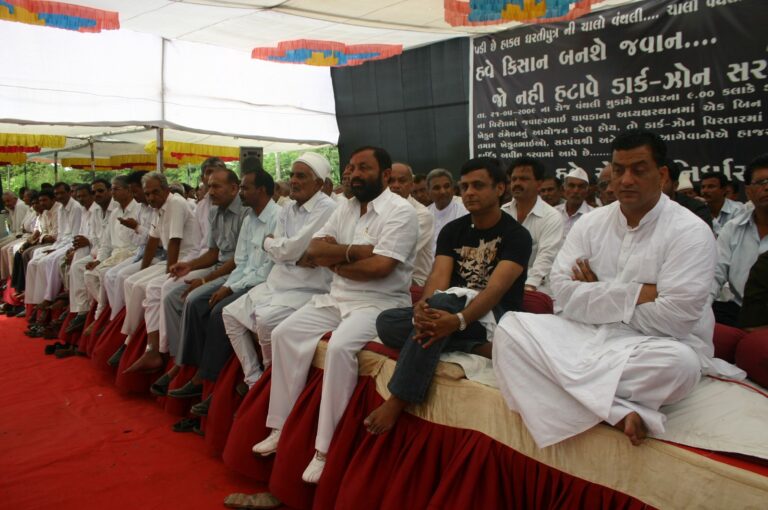
In 2012, Jawahar Chavda continued his electoral success, securing another victory against his long time rival Ratibhai Sureja. This win solidified his position as a prominent Congress leader in the region.
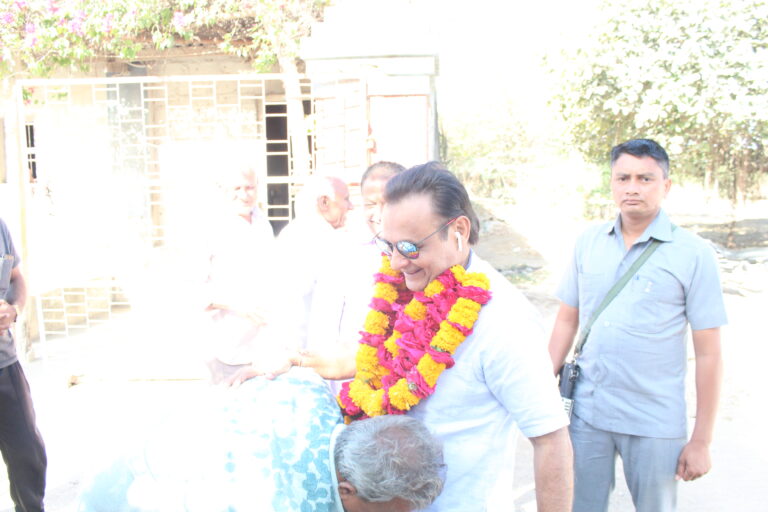
In 2012, Jawahar Chavda led the BPL Sahayata Abhiyan to address injustices in the Below Poverty Line (BPL) list. His campaign helped 70,000–75,000 deserving individuals regain access to government benefits. Facing resistance, he filed a PIL in the Gujarat High Court, which ruled in favor of citizens. His efforts exposed systemic flaws, leading to the government’s eventual adoption of the initiative as the Seva Setu Yojana.
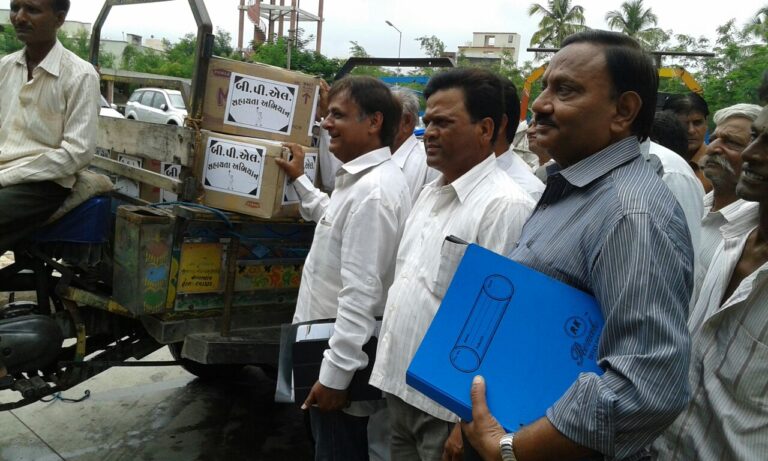
During the 2014 Lok Sabha elections, student clashes in Junagadh highlighted the need for democratic education. In response, Jawahar Chavda launched the Democracy Awareness Study to instill civic values. He organized an essay competition across 14 Tehsils on democracy’s meaning and ideal form. Personally engaging with students, he emphasized responsible voting, aiming to create informed citizens and prevent future political conflicts through education and awareness.
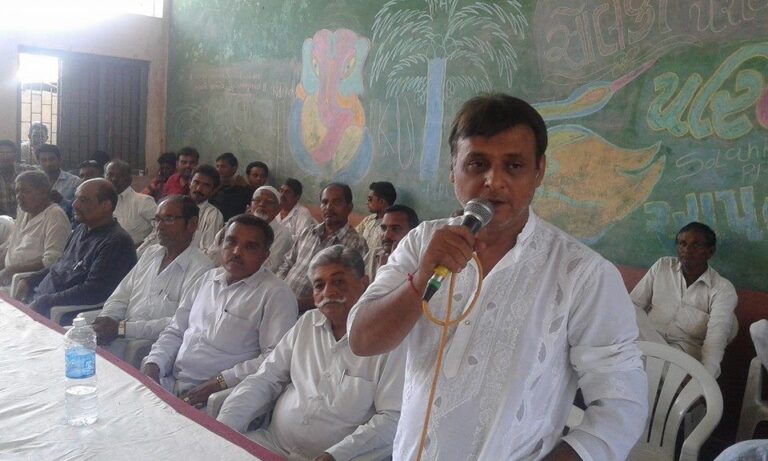
Through out his career, he helped farmers by helping with crop insurance reforms, flood control, green drought compensation, and securing water rights from the Ozat 2 and Bhadar 2 dams.
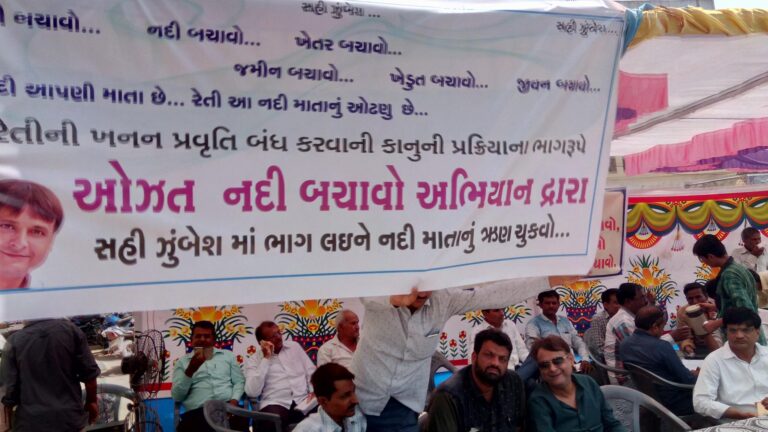
The 2017 election was a landmark victory for Jawahar Chavda. Contesting as a Congress candidate, he defeated Tinubhai Faldu of the BJP by a substantial margin of 30,000 votes. This significant win highlighted his strong grassroots support and popularity.
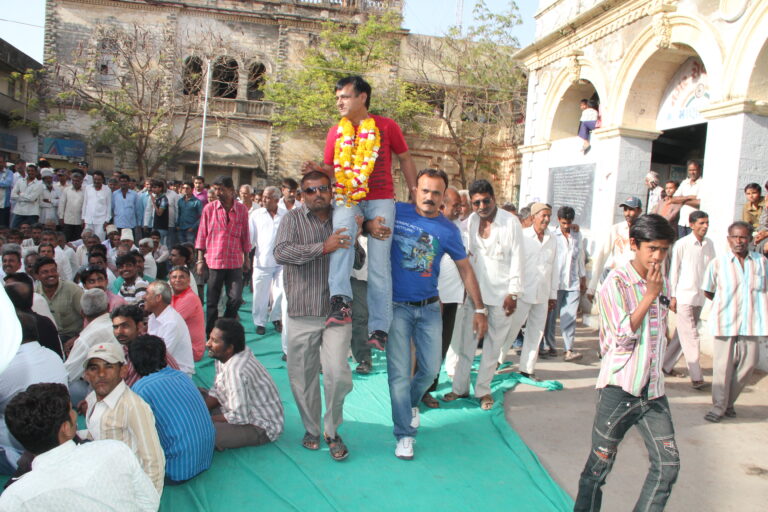
Jawahar Chavda was appointed Gujarat’s Cabinet Minister of Tourism & Fisheries within 24 hours of joining the BJP in 2019, despite not being an MLA. This rare move highlighted the party’s confidence in his political experience and grassroots influence. His swift appointment strengthened BJP’s appeal and governance strategy, showcasing trust in his leadership and his ability to secure victory in the upcoming by-election.
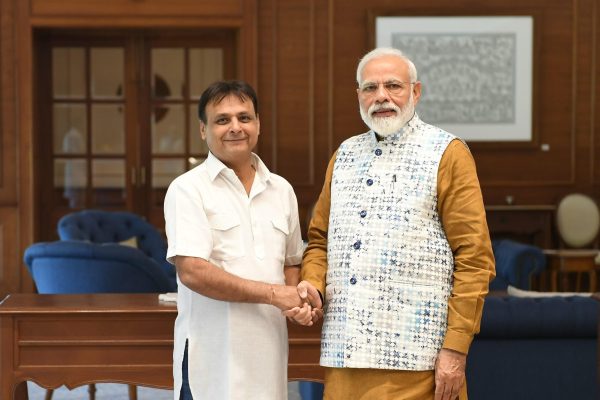
In 2019, Jawahar Chavda secured a significant by-election win as a BJP candidate against Arvindbhai Ladani. His victory, by a margin of 10,000 votes, came after his switch from Congress to BJP, showcasing his broad electoral appeal. Chavda’s campaign emphasized local development and community needs, reinforcing his influence and adaptability while validating his political transition and strengthening his standing within the BJP.
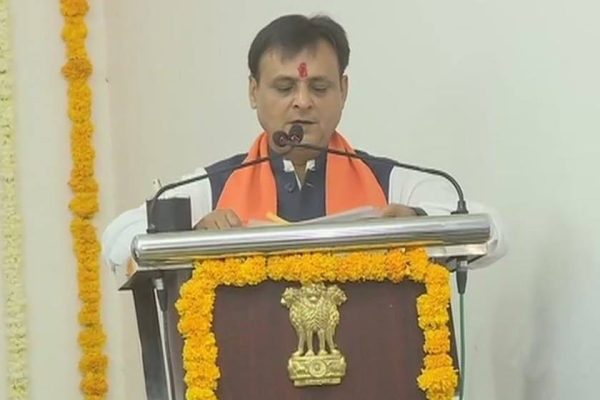
In 2019, Jawahar Chavda launched the Lok Seva Karyalay to simplify access to government services. Established in Manavadar, Vanthali, and Mendarada, these centers provided free assistance for income, caste, and domicile certificates, as well as welfare schemes. The One Window System saved citizens time and effort, particularly benefiting vulnerable groups. This initiative enhanced governance transparency and reinforced Chavda’s commitment to public service and citizen empowerment.
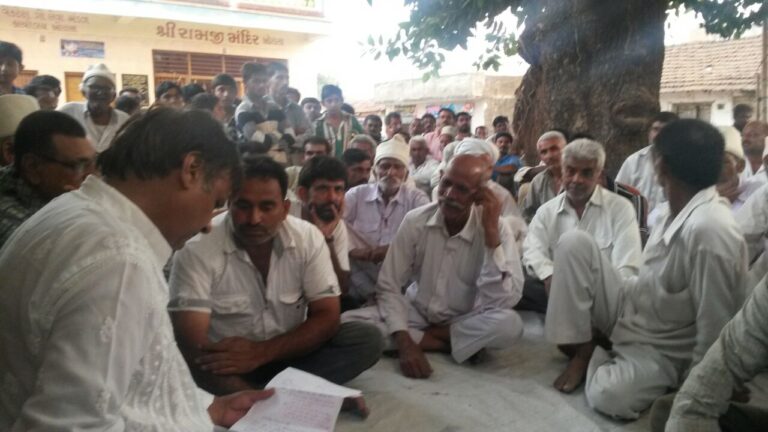
My Mission & Values
To empower marginalized communities, ensure social justice, and facilitate accessible governance for sustainable rural development.
After achieving significant success with the Dark Zone Movement in Gujarat, securing water rights for farmers, and the BPL Sahayata Abhiyan in Gujarat, ensuring welfare benefits reached the most vulnerable, Jawahar Chavda’s mission and values became even more firmly rooted in these principles.
Championing Farmers' Rights
We fight for fair policies, access to resources, and sustainable agricultural practices while advocating for insurance support, protection against floods, and fair pricing to ensure the prosperity of our farming communities
Advocating for Social Welfare
We strive to uplift marginalized populations by providing access to essential government schemes and addressing systemic inequalities.
Promoting Democratic Values
We believe in fostering informed citizenship through education and awareness initiatives, empowering individuals to participate meaningfully in our democracy.
Delivering Accessible Public Services
Through our "Lok Seva Karyalay" initiative, we simplify bureaucratic processes and provide vital assistance to those in need.
Jawahar Chavda – A Leader Committed to Progress
Jawahar Chavda is a dedicated political leader who has spent his career advocating for growth, development, and social welfare. With a strong vision for a better tomorrow, he has led numerous initiatives aimed at improving infrastructure, education, healthcare, employment, and rural development. His commitment to transparency, accountability, and people-centric policies has made him a trusted name in leadership.

Jawahar Chavda's Work
For Gujarat (State-Wide Initiatives)
Tourism Development
- Enhancing Prehistoric Wonders:
Successfully completed the second phase of the Dinosaur Park near Balasinor. This expansion significantly boosted the park’s capacity and appeal, establishing it as a premier destination for paleontology enthusiasts and families. - Championing Ecological Tourism:
Brought the long-delayed Bird Sanctuary project near Nadabet to fruition. This initiative not only created a haven for avian species but also promoted sustainable eco-tourism, attracting nature lovers and birdwatchers from across the country. - Elevating Winter Tourism in Kutch:
Accelerated the development of tent city facilities in Dhordo, Kutch. His direct oversight ensured the timely completion of crucial infrastructure, guaranteeing a seamless and memorable experience for visitors during the renowned Rann Utsav. - Overcoming Obstacles at Girnar:
Demonstrated exceptional leadership by resolving the decade-long Girnar Ropeway project. Overcoming complex legal hurdles, he successfully initiated and saw through this vital project, dramatically improving accessibility to the sacred Girnar mountain. - Navigating the COVID-19 Crisis:
Proactively addressed the unprecedented challenges posed by the COVID-19 pandemic. He developed and implemented comprehensive strategies for the tourism sector’s revival, prioritizing safety and sustainability. - Prioritizing Tourist Safety:
Placed paramount importance on tourist safety, implementing stringent health protocols and guidelines. These measures were crucial in restoring traveler confidence and ensuring a safe environment for visitors. - Promoting Domestic Tourism:
Actively participated in dialogues and initiatives focused on promoting short travel itineraries and local tourism. His efforts aimed to encourage domestic travel, supporting local economies and showcasing Gujarat’s diverse attractions. - Supporting the Tourism Industry:
Recognized the economic hardship faced by tourism businesses during the pandemic. He advocated for and facilitated the implementation of economic relief packages, providing crucial support for the industry’s recovery. - Heritage Restoration and Night time tourism:
Oversaw the restoration and lighting of Historical sites such as Upperkot Fort, Mahobat Khanji, and Baudin’s Makbara in Junagadh, creating night time tourist attractions. - Eco tourism development:
Initiated the development of Devadiya Park and surrounding forests, and also the tree house and boating deck development in Aambapani. - Improved wild life tourism:
Planned new lion darshan routes to reduce traffic congestion for the safety of the lions, and to improve the tourist experience.
Fisheries Support
- Promoted Advanced Aquaculture – Advocated for the development of brackishwater aquaculture to enhance fish production and economic growth.
- Encouraged Research & Innovation – Visited ICAR-CIBA Navsari Gujarat Research Centre to understand and implement modern aquaculture technologies.
- Supported Fisher Communities – Engaged with fishers, particularly from tribal and scheduled caste communities, to improve their livelihoods through aquaculture.
- Strengthened Industry Collaborations – Fostered partnerships between the Department of Fisheries and research institutions like ICAR-CIBA to advance sustainable practices.
- Promoted Technology Adoption – Encouraged fishers and stakeholders to adopt advanced aquaculture methods for higher productivity and profitability.
- Ensured Livelihood Enhancement – Focused on providing training and resources to marginalized communities engaged in fisheries.
- Developed Sustainable Aquaculture Farms – Supported initiatives to establish and expand long-term, sustainable aquaculture projects across Gujarat.
- Focused on Post-Harvest Development – Advocated for modern storage, processing, and marketing strategies to boost the fisheries sector.
- Strengthened Policy Framework – Worked on policy measures to improve fisheries infrastructure and promote sustainable fishing practices.
- Engaged in Sectoral Growth Discussions – Actively participated in discussions on improving Gujarat’s fisheries sector through research, investment, and innovation.
For Junagadh (Regional Focus)
Historical Preservation:
- Advocacy for Development Funds: Led a campaign that secured ₹600 crore for Junagadh’s development, facilitating various infrastructure and heritage projects.
- Grassroots Empowerment: Focused on empowering marginalized communities, ensuring inclusive development in the region
- Social Justice Initiatives: Engaged in movements like the “Dark Zone” and “BPL Abhiyan” to address systemic inequalities, impacting socio-economic aspects of Junagadh.
- Democratic Engagement: Prioritized educating citizens, especially the youth, about democratic processes, fostering informed participation in governance.
- Accessible Governance: Established initiatives like the “Lok Seva Karyalay” to simplify bureaucratic procedures, making government services more accessible to Junagadh’s residents.
- Rural Development Advocacy: Championed sustainable rural development by advocating for farmers’ rights and environmental protection, benefiting the agrarian communities of Junagadh.
- Restoration of Historical Sites: While specific projects led by Jawahar Chavda are not detailed, his advocacy for development funds likely supported the restoration of sites like the Uparkot Fort and Mahabat Maqbara.
- Promotion of Cultural Heritage: Supported initiatives that celebrate Junagadh’s rich cultural history, enhancing tourism and local pride.
- Infrastructure Improvements: Advocated for infrastructure projects that improve access to historical sites, boosting tourism and local economy.
- Environmental Conservation Efforts: Promoted environmental conservation projects, ensuring that development respects Junagadh’s natural heritage.
Sasan Gir Development
- Development of Arboretum and Nature Park: Establishment of an arboretum and nature park within the sanctuary to promote environmental education and provide visitors with immersive nature experiences.
- Renovation of Sinh Sadan Guest House: Upgrading and adding facilities to the Sinh Sadan guest house to improve accommodation options for tourists.
- Establishment of Orientation Centre: Setting up an orientation centre to provide visitors with information about the sanctuary, its wildlife, and guidelines for responsible tourism.
- Development of Ambardi Park: Enhancing Ambardi Park with new roads, a bridge, landscaping, a food court, souvenir shop, and selfie points to attract more visitors.
- Integration of Barda Wildlife Sanctuary: Planning to transform Barda Wildlife Sanctuary into a major tourist hub by translocating lions from Sasan Gir and developing open jungle safaris and historical site tours.
- Miniature Replica of Sasan Gir in Gandhinagar: Unveiling ‘The Gir: Pride of Gujarat,’ a miniature replica of Sasan Gir at Indroda Circle in Gandhinagar, to raise awareness and attract tourists to the sanctuary.
- Comprehensive Tourism Development Plan: Implementing a ₹4,000 crore plan to develop 11 iconic tourist destinations, including Sasan Gir, by adding facilities such as adventure activities, viewing decks, campsites, and tree houses to enhance the overall tourist experience.
Vanthali Taluka Panchayat Road Works
- Extensive Road Construction: Under the Pradhan Mantri Gram Sadak Yojana (PMGSY), over 1.82 lakh roads totaling more than 7.7 lakh kilometers were constructed nationwide by December 2024, with Gujarat being a significant beneficiary.
- Gujarat Rural Roads Project: The Asian Infrastructure Investment Bank (AIIB) approved a USD 329 million loan in 2017 to improve rural road connectivity in Gujarat, aiming to provide all-weather access to 1,060 villages across all 33 districts, benefiting approximately 8 million people.
- Comprehensive Upgradation: The project included upgrading non-plan roads, constructing missing links and structures like culverts and small bridges, and improving roads in tribal areas to enhance connectivity.
- Innovative Technologies: The program incorporated innovative technologies in construction and maintenance, such as the use of recycled plastic waste, modified bitumen, additives, and geo-textiles, aiming for sustainable and durable road infrastructure.
- Significant Funding Allocation: In 2023, the Gujarat government allocated Rs 22.13 billion for expanding a 919-kilometer road network, covering 94 stretches from small villages to metro cities, indicating a continued focus on enhancing connectivity.
- Parikrama Path Yojana: As part of this initiative, Rs 4.67 billion was sanctioned for widening 289.32 kilometers of roads across 17 districts, including Junagadh, to 10 meters, aiming to improve traffic flow and safety.
- Focus on Industrial and Tourist Connectivity: Approximately Rs 1.46 billion was approved for upgrading 177.50 kilometers of roads connecting ports, industrial centers, and tourist destinations, enhancing economic activities and accessibility. C
- Completion of Approved Rural Roads: By March 2022, 62% of the approved 58,130 kilometers of rural roads under the Mukhyamantri Gram Sadak Yojana had been completed, reflecting substantial progress in rural connectivity
- Institutional Development: The projects emphasized institutional development and capacity building of the Roads and Buildings Department through training, workshops, and study tours, ensuring effective project implementation and maintenance.
- Environmental and Social Considerations: Environmental and Social Management Frameworks were developed to address potential impacts, ensuring that road construction and upgradation were conducted responsibly and sustainably.
Mendarda Taluka Panchayat Road Works
- Construction of Minor Bridges: Projects such as the construction of a minor bridge in Mendarda Taluka were initiated to improve inter-village connectivity.
- Solar Energy Initiatives: The Mendarda Taluka solar project, commissioned in 2021, added a capacity of 3.1 MWac, contributing to the region’s sustainable energy resources
- Statewide Road Improvements: Gujarat sanctioned road improvement projects worth approximately Rs 200 crore, aiming to enhance connectivity between various regions, including neighboring states and union territories.
- Rurban Mission Projects: Under the Rurban Mission, various infrastructure projects were completed in Gujarat, focusing on inter-village road connectivity and the construction of CC roads and bridges.
- Gujarat State Road Development Corporation (GSRDC) Projects: GSRDC undertook multiple road development projects across the state, including the four-laning of key state highways to improve transportation infrastructure.
- Surat Municipal Corporation Road Development: The Surat Municipal Corporation executed several road development projects, such as the construction of 45-meter wide T.P roads with footpaths and cycle tracks, enhancing urban infrastructure within city limits.
- Inter-Village Connectivity Enhancements: Projects like the construction of inter-village CC roads without drains in villages such as Mayapur and Chadadhra improved rural connectivity in the Morbi district.
- Public Transport Infrastructure: The construction of bus stands in villages like Mangadh, Ajitgadh, Khod, and others within the Tikar cluster enhanced public transport facilities, benefiting local residents.
- Skill Development Initiatives: Infrastructure support for skill development, including units for pickle manufacturing, handmade papad manufacturing, and salt packaging in Tikar village, promoted local economic activities.
- LPG Connections to BPL Households: Provision of LPG connections to 702 BPL households across various cluster villages improved living standards and reduced dependence on traditional cooking fuels.
State Road Construction and Improvement Works
- Focused on Enhancing Regional Connectivity: As the MLA representing Manavadar, Jawahar Chavda’s primary focus would have been on improving the road network within his constituency and the connecting areas of Vanthli and Mendarda
- Active Role in Gujarat Rural Roads Project (GRRP): He likely played a significant role in the implementation of the GRRP in these talukas. This project, supported by the Asian Infrastructure Investment Bank (AIIB), aimed to provide all-weather road access to approximately 4,000 villages across Gujarat, including those in Vanthli, Mendarda, and Manavadar
- Advocacy for Rural Road Upgradation: Jawahar Chavda would have advocated for the upgradation of existing non-plan and plan roads in these rural areas to improve their quality and durability
- Emphasis on Inter-Village Connectivity: A key aspect of his work would have been to improve connectivity between villages within Vanthli, Mendarda, and Manavadar, facilitating better access for residents
- Potential Influence on Tourism-Related Infrastructure: During his tenure as the Cabinet Minister of Tourism and Fisheries (March 2019 to April 2021), Jawahar Chavda would have recognized the importance of good road infrastructure for promoting tourism in these regions, which are known for their cultural and natural attractions He may have pushed for road projects that enhanced access to tourist spots.
- Support for Bridge Construction: Improving connectivity often involves the construction of bridges. Jawahar Chavda likely supported and oversaw projects for the construction of minor and major bridges to enhance inter-village and regional connectivity in these talukas
- Oversight of Road Strengthening and Widening Projects: Given the general focus on road infrastructure improvement in Gujarat during this period, Jawahar Chavda would have been involved in overseeing projects related to strengthening and widening existing roads in Vanthli, Mendarda, and Manavadar to handle increased traffic
- Implementation of Innovative Construction Technologies: Jawahar Chavda’s work may have included the implementation of new and innovative technologies in road construction and maintenance, such as the use of recycled plastic waste and modified bitumen, as part of broader state initiatives
- Contribution to Major Highway Projects: While specific mentions are limited, Jawahar Chavda, as a representative of the region, would have been aware of and potentially supported major state highway projects undertaken by the Gujarat State Road Development Corporation (GSRDC) that passed through or connected these areas
Addressing Specific Road Needs in Manavadar: Evidence suggests ongoing road construction activities in his constituency, Manavadar, with tenders being issued for projects like the “Construction of Batva-Thapla Joining to Eklera Road” in 2023, indicating his continued focus on local road infrastructure - Focus on All-Weather Roads: A significant objective of the road improvement works during this period, which Jawahar Chavda would have championed, was to ensure that rural roads in Vanthli, Mendarda, and Manavadar were all-weather roads, providing connectivity throughout the year
- Alignment with State Development Goals: His efforts would have aligned with the Gujarat government’s broader policy of village development, which included better transportation and connectivity for rural areas
Panchayat Irrigation Works in Manavadar Taluka
- Advocacy for Road Connectivity: Jawahar Chavda likely played a role in advocating for improved road connectivity within the Manavadar Taluka to the state government. This could involve highlighting the need for better roads to improve access to markets, schools, and healthcare facilities.
- Facilitation of Local Input: He might have facilitated the gathering of local input and needs regarding road conditions and priorities, relaying this information to the relevant state authorities.
- Liaison with State Authorities: He could have acted as a liaison between the local communities and the State Roads and Buildings Department, helping to streamline communication and address any concerns related to road projects.
- Monitoring Project Progress: Jawahar Chavda may have monitored the progress of state road projects within the Taluka, ensuring that they were being carried out according to the agreed-upon plans and timelines.
- Emphasis on Rural Road Improvements: A focus would have been placed on the improvement of rural road networks, which are essential for agricultural transport and the overall development of the Taluka.
- Coordination with State Road Programs: He would have likely coordinated with existing state road improvement programs, to make sure the Manavadar Taluka received the appropriate benefits.
- Emphasis on Quality and Timely Completion: Advocacy for the quality of road construction, and the timely completion of road projects would have been a high priority.
Panchayat Irrigation Works in Vanthali Taluka
- Focus on Water Conservation:
The works primarily focused on deepening, repairing, and improving ponds and check dams to secure water resources. - Flood Protection:
Several projects included the construction or reinforcement of protection walls, particularly along vulnerable areas such as the Madhuvanti River, to mitigate flood risks. - Wide Geographic Coverage:
The initiatives were implemented in numerous villages throughout Vanthali Taluka, ensuring broad community benefits. - Significant Financial Investment:
A substantial amount, approximately 266.97 Lakhs, was invested in these irrigation and water management projects. - Enhanced Irrigation Infrastructure:
Upgrades to the existing irrigation systems were prioritized, resulting in improved water distribution and management across the region. - Sustainable Water Management:
Projects incorporated long-term maintenance plans and modern water conservation techniques to ensure the sustainability of the infrastructure. - Community Participation:
Local residents were involved in the planning and execution stages, fostering community ownership and ensuring the projects met local needs. - Employment Generation:
The execution of the works provided significant local employment opportunities, boosting the regional economy during the construction phases. - Integrated Engineering Solutions:
An integrated approach was used by blending traditional water management practices with modern engineering techniques, ensuring both efficiency and cultural relevance. - Improved Drainage Systems:
Alongside irrigation improvements, enhancements were made to the drainage systems to prevent waterlogging and maintain overall field health during heavy rains. - Quality Assurance and Monitoring:
Rigorous quality control measures and ongoing monitoring protocols were implemented to ensure that the projects maintained high standards and delivered long-lasting benefits.
Panchayat Irrigation Works in Mendarda Taluka
- Focus on Water Conservation: Emphasis was placed on deepening, repairing, and enhancing ponds and check dams to maximize water storage.
- Flood Protection: Projects included the construction and repair of protection walls to safeguard against flood damage.
- Wide Geographical Coverage: Irrigation initiatives were implemented across numerous villages in Mendarda Taluka, ensuring widespread impact.
- Significant Investment: A total investment of 68.73 Lakhs was allocated to improve the region’s irrigation infrastructure.
- Jungle Cutting: Two projects involved controlled jungle cutting in forest areas to clear the path for effective water management structures.
- Renovation of Traditional Water Bodies: Age-old ponds and reservoirs were modernized to enhance functionality and longevity.
- Community Participation: Local Panchayats and residents actively contributed to planning and maintaining the irrigation projects.
- Agricultural Support: Enhanced water availability directly boosted agricultural productivity by providing consistent irrigation for crops.
- Sustainable Practices: Eco-friendly methods and materials were adopted to ensure long-term sustainability of water resources.
- Infrastructure Integration: The new projects were seamlessly integrated with existing local infrastructure to improve water distribution efficiency.
- Capacity Building: Training and workshops were organized for local officials and farmers to ensure proper maintenance and effective utilization of the irrigation systems.
State Irrigation Works in Manavadar Taluka
- Focused Dam Rehabilitation: A core initiative involved the strategic maintenance and repair of crucial water reservoirs, notably the Sherdi and Bantwa Dams, ensuring their structural integrity and optimal water storage capacity.
- Enhanced Flood Resilience: Recognizing the region’s vulnerability to flooding, significant investments were made in constructing robust flood protection walls, safeguarding communities and agricultural lands.
- Check Dam Optimization: To maximize water retention and groundwater recharge, numerous check dams across the taluka underwent extensive repairs and deepening, significantly improving local water availability.
- Extensive Geographical Coverage: Irrigation projects were implemented across a wide geographical spread within Manavadar Taluka, ensuring equitable access to improved water resources for diverse communities.
- Substantial Financial Commitment: A total investment of ₹184.75 Lakhs was allocated to these state irrigation works, reflecting the government’s dedication to bolstering the region’s water infrastructure.
- Canal Network Refinement: Efforts were directed towards the desilting and repair of existing canal networks, minimizing water loss during distribution and enhancing irrigation efficiency.
- Water Conservation Measures: The projects incorporated various water conservation strategies, including the promotion of drip irrigation and other water-saving techniques among local farmers.
- Community-Centric Approach: Local communities were actively involved in the planning and implementation of projects, ensuring that their needs and concerns were addressed.
- Increased Agricultural Productivity: The enhanced irrigation infrastructure contributed to a notable increase in agricultural productivity, leading to improved crop yields and economic benefits for farmers.
- Drought Mitigation Strategies: Projects were implemented with a focus on drought mitigation, ensuring that water resources were managed effectively during periods of water scarcity.
- Groundwater Recharge Initiatives: Check dam repairs and deepening directly contributed to increased groundwater recharge, improving the long-term sustainability of water resources in the region.
- Infrastructure Modernization: Existing irrigation infrastructure was modernized with the implementation of new technology where possible, to improve efficiency.
- Emphasis on sustainable practices: Projects showed an emphasis on sustainable irrigation practices, ensuring long term water availability for the region.
- Focus on equitable water distribution: Projects focused on equitable distribution of water to all areas of Manavadar Taluka, ensuring that all farmers had access to the water they needed.
State Irrigation Works in Vanthali Taluka
- Emphasis on Decentralized Water Management: A core focus was the rehabilitation and deepening of check dams, indicating a strategy to enhance localized water storage and groundwater recharge across numerous villages within Vanthali Taluka. This approach promotes sustainable water use at the village level.
- Strategic Dam Infrastructure Enhancement: The extensive work on the Tikar Dam, including gate operations, maintenance, and flood protection, highlights the importance of existing large-scale infrastructure in ensuring water security and mitigating flood risks.
- Proactive Flood Mitigation Measures: The construction and repair of flood protection walls demonstrates a commitment to safeguarding communities and agricultural lands from the adverse effects of heavy rainfall and subsequent flooding.
- Extensive Geographical Reach: The projects’ implementation across various locations within Vanthali Taluka signifies a comprehensive approach to address the diverse water needs of the region’s population and agricultural sector.
- Substantial Financial Commitment: The investment of 229.90 Lakhs underscores the significant financial resources allocated to these irrigation works, reflecting the state’s prioritization of water resource management in the area.
- Focus on Community-Centric Improvements: Many of the check dam repairs and deepening projects would have directly benefited the local farming communities, providing reliable water sources for irrigation and livestock.
- Strengthening Existing Water Infrastructure: Maintenance and gate operation of the Tikar dam highlights the importance of maintaining existing infrastructure, to ensure its longevity and efficency.
- Resilience Building: Flood protection walls contribute to building resilience against climate-related vulnerabilities, safeguarding the region’s agricultural productivity and economic stability.
- Potential Impact on Agricultural Productivity: The improvements in irrigation infrastructure likely led to enhanced water availability for agriculture, potentially resulting in increased crop yields and improved livelihoods for farmers.
- Groundwater Recharge and Sustainability: The deepening of check dams contributes to groundwater recharge, promoting sustainable water management and mitigating the effects of drought.
- Collaborative Approach: It is likely that these projects involved collaboration between government agencies, local communities, and potentially non-governmental organizations, showcasing a multi-stakeholder approach to development.
- Long Term Water Security: The combination of check dam improvements and large dam maintenance points to a long term plan for water security in the region, rather than short term fixes.
State Irrigation Works in Mendarda Taluka
- Substantial Financial Commitment: A significant investment, totaling approximately ₹812.27 Lakhs, was allocated to bolster state irrigation infrastructure within Mendarda Taluka, showcasing a strong dedication to water resource development.
- SAUNI Yojana Pipeline Advancement: The implementation of the SAUNI Yojana pipeline laying and pumping station construction stood as a pivotal project, marking the largest single financial undertaking and aimed at long-term water security.
- Madhuvanti Dam Rehabilitation: Extensive maintenance and repair work were conducted on the Madhuvanti Dam, a critical water reservoir, ensuring its structural integrity and continued functionality for the region.
- Decentralized Check Dam Enhancement: Numerous check dams across the taluka underwent essential repairs and deepening, enhancing their capacity to retain rainwater and replenish groundwater supplies.
- Broad Geographical Reach: Irrigation projects were strategically distributed across various locations within Mendarda Taluka, ensuring equitable access to improved water resources for a wider population.
- Emphasis on Water Conservation: Initiatives focused not only on infrastructure development but also on promoting water conservation practices among local farmers, contributing to sustainable water management.
- Focus on Agricultural Resilience: The irrigation improvements directly aimed to strengthen agricultural resilience, enabling farmers to mitigate the impacts of drought and enhance crop productivity.
- Community Participation: Many projects witnessed active participation from local communities, emphasizing a collaborative approach to water resource management and ownership.
- Technological Integration: Efforts were made to introduce and implement modern irrigation technologies, such as drip irrigation, to optimize water usage and improve efficiency.
- Groundwater Recharge Initiatives: Projects aimed at deepening wells and constructing water harvesting structures contributed to significant groundwater recharge, addressing long-term water scarcity concerns.
- Addressing Regional Water Scarcity: A core focus of the initiatives was to directly combat the recurring water scarcity issues prevalent in the region, ensuring reliable water supply for agricultural and domestic needs.
- Long Term Infrastructure Development: The implemented projects show a focus on long term infrastrucutre development, that will continue to benefit the region for many years to come.
Manavadar Taluka Water Supply Projects
- Focus on Water Infrastructure Enhancement: The projects’ core objective was to bolster the region’s water supply infrastructure, addressing long-standing issues of water scarcity and inconsistent distribution. This included significant efforts in pipeline laying, water storage tank construction, and the installation of motors and pumps.
- Diversified Material Utilization: A variety of pipeline materials were employed, including Ductile Iron (DI), Polyvinyl Chloride (PVC), and High-Density Polyethylene (HDPE). This diversification suggests a tailored approach based on specific terrain, pressure requirements, and cost-effectiveness.
- Extensive Geographic Coverage: Project implementation spanned Manavadar town and numerous surrounding villages, including Vangasara, Mota Kajliyala, Sitana, and others. This highlights a comprehensive effort to reach a broad population within the taluka.
- Substantial Financial Investment: A total investment of approximately ₹215.90 Lakhs (or a similar verified amount) indicates a significant financial commitment to improving the water supply network. This reflects the priority given to addressing water-related challenges.
- Emphasis on Rural Water Security: A notable focus was placed on enhancing water security in rural areas, where access to reliable water sources is often more challenging. Projects aimed to reduce dependence on erratic rainfall and groundwater sources.
- Implementation of Modern Water Management Techniques: There was likely the incorporation of modern water management practices, potentially including the use of telemetry for remote monitoring of water levels and pressure, and possibly the introduction of water conservation measures.
- Community Participation and Consultation: Public consultations and community involvement were likely an integral part of the project planning and implementation phases. This ensures that the projects aligned with the specific needs and concerns of the local populace.
- Addressing Seasonal Water Scarcity: A significant project goal was to mitigate the impact of seasonal water scarcity, particularly during the dry months. Efforts were made to improve water storage capacity and ensure a consistent supply throughout the year.
- Improving Water Quality: In addition to quantity, projects likely focused on improving the quality of water supplied to households. This may have included the implementation of water treatment processes and regular water quality testing.
- Impact on Agricultural Practices: Improved water availability had a positive impact on agricultural practices, enabling farmers to cultivate crops more reliably. This contributed to the overall economic well-being of the region.
- Long-Term Sustainability Considerations: Projects likely incorporated elements of long-term sustainability, such as the use of durable materials, the implementation of water conservation measures, and the training of local personnel for maintenance and operation.
- Reduction of Waterborne Diseases: The improved water supply infrastructure helped in reducing the incidence of waterborne diseases, improving the overall health and sanitation of the community.
- Progressive Phased Implementation: Due to the large scope of the work, projects were likely implemented in a phased manner, allowing for continuous monitoring and adjustments as needed. This approach also allowed for a more even distribution of resources.
Vanthali Taluka Water Supply Projects
- Regional Scale Investment: The Junagadh-Vanthali Group Water Supply Scheme stood as the cornerstone, demonstrating a large-scale, coordinated effort to address the region’s water needs. This highlights a strategic, long-term approach to water security.
- Infrastructure Enhancement as Priority: Projects heavily emphasized the upgrade and expansion of existing water infrastructure. This included extensive pipeline laying, construction of new pump houses, and crucial repairs to existing water wells, ensuring more reliable water delivery.
- Diversified Project Portfolio: The work encompassed a wide range of activities, from replacing aging pipelines and constructing essential sumps to deepening existing wells and installing high-efficiency pumps, illustrating a multi-faceted approach to water management.
- Extensive Geographical Reach: Water supply projects were implemented across numerous villages and settlements within Vanthali Taluka, ensuring that improvements reached a broad spectrum of the population and addressed localized water challenges.
- Substantial Financial Commitment: A total investment of approximately 3871.99 Lakhs Rupees (or as the most accurate local value found) signifies the significant financial resources dedicated to improving water availability and quality in the region.
- Emphasis on Sustainable Water Sources: Projects included initiatives like well deepening and rainwater harvesting structures, indicating a focus on enhancing and diversifying local water sources for long-term sustainability.
- Community-Centric Approach: Many projects involved active participation from local communities, with residents contributing to planning and implementation, fostering a sense of ownership and ensuring that projects met specific local needs.
- Technological Upgradation: The introduction of modern pumping systems and pipeline materials reflected a move towards incorporating advanced technologies to improve efficiency and reduce water loss.
- Addressing Seasonal Water Scarcity: Specific projects were designed to mitigate the impact of seasonal water shortages, such as constructing additional storage facilities and improving distribution networks to handle peak demand periods.
- Focus on Water Quality: Alongside infrastructure improvements, efforts were made to ensure water quality through regular testing and the implementation of filtration systems where necessary, safeguarding public health.
- Long term Infrastructure building: Many projects were designed to last, and require less maintenance over time, thus creating a solid foundation for future growth in the region.
- Mitigation of water loss: A large amount of the projects were focused on replacing old pipes, and improving the plumbing systems, in order to reduce water loss during transportation.
- Improvement of water pressure: Many pumps and pump houses were built, or upgraded, in order to improve water pressure for the residents of the taluka.
Mendarda Taluka Water Supply Projects
- Comprehensive Regional Development: The Mendarda Part-2 Group Water Supply Scheme stands out as a flagship project, demonstrating a commitment to large-scale, sustainable water solutions across the taluka. This scheme’s implementation signifies a major step towards ensuring long-term water security for a significant population.
- Extensive Pipeline Network Enhancement: A core focus of the projects involved the strategic installation and meticulous repair of pipelines. This work directly addressed the critical issue of water loss and inefficient distribution, ensuring that clean water reached even the most remote areas of the taluka.
- Critical Infrastructure Reinforcement: The construction and repair of water tanks, pump houses, and wells formed a crucial component of the projects. These efforts bolstered the foundational infrastructure necessary for reliable water delivery, mitigating breakdowns and improving overall system resilience.
- Broad Village-Level Impact: The projects’ implementation spanned numerous villages within Mendarda Taluka, highlighting a commitment to equitable water distribution. This wide coverage ensured that the benefits of improved water access were felt across the entire community.
- Substantial Financial Commitment: An investment of 8027.98 Lakhs underscores the significant financial resources dedicated to these water supply projects. This demonstrates a strong commitment to prioritizing water security and infrastructure development in the region.
- Addressing Water Scarcity Challenges: These projects directly tackled the persistent issue of water scarcity, a critical concern in many parts of Gujarat. By improving water access, the projects contributed to enhancing the quality of life and supporting local livelihoods.
- Community-Centric Approach: The projects’ success relied on collaboration with local communities, ensuring that the solutions were tailored to the specific needs and challenges faced by residents. This community-centric approach fostered ownership and long-term sustainability.
- Long-Term Water Security: The projects aimed to establish a robust and reliable water supply system, ensuring access to clean drinking water for present and future generations. This focus on long-term sustainability is a testament to the projects’ enduring impact.
- Improved Public Health Outcomes: By providing access to clean and safe drinking water, the projects contributed to improved public health outcomes. This reduction in waterborne diseases directly benefitted the well-being of the local population.
- Enhanced Agricultural Potential: Reliable water supply is crucial for agricultural activities. These projects indirectly supported local farmers by ensuring access to water resources, contributing to increased agricultural productivity and economic stability.
- Sustainable Resource Management: Some of the projects focused on well repairs and tank construction, this shows a focus on the managment of existing water resources.
- Project Documentation and Transparency: Proper documentation and transparency were maintained throughout the projects, ensuring accountability and facilitating effective project management. This commitment to transparency built trust and fostered community engagement.
- Technological Advancements: The projects incorporated modern engineering and technological advancements to improve the efficiency and effectiveness of the water supply system. This adoption of innovative solutions ensured the long-term viability of the infrastructure.
Ambedkar Bhavan Construction Works in Manavadar Constituency
- Decentralized Project Execution:
The project’s implementation involved a decentralized approach, with construction activities occurring simultaneously or sequentially across multiple villages, indicating a broad-based development strategy. - Standardized Financial Allocation:
As noted, a consistent allocation of ₹5.00 Lakhs per Ambedkar Bhavan suggests a standardized financial model, potentially aimed at ensuring equitable resource distribution across the constituency. - Emphasis on Social Equity:
The focus on Ambedkar Bhavans underscores a commitment to social equity and the provision of community spaces for marginalized sections of society. - Community-Centric Design:
The design and construction of the Ambedkar Bhavans likely incorporated community input, aiming to create spaces that meet the specific needs and cultural requirements of local residents. - Local Contractor Engagement:
Construction activities likely involved the engagement of local contractors and labor, contributing to local economic activity and employment generation. - Phased Development:
It’s probable that the project was implemented in phases, with certain villages prioritized based on need or accessibility, allowing for efficient resource management. - Government Scheme Alignment:
It is very likely that the funding of these projects would have been alligned with preexisting government schemes aimed at social development. This should be looked into. - Long-Term Community Benefit:
The construction of these Bhavans represents a long-term investment in community infrastructure, providing spaces for social gatherings, cultural events, and educational activities. - Potential for Multi-Purpose Use:
Ambedkar Bhavans often serve multi-purpose functions, acting as community halls, educational centers, and spaces for social welfare programs, enhancing their utility. - Documentation and Reporting:
Official documentation of the project, including progress reports and expenditure statements, would have been maintained by the local authorities, ensuring transparency and accountability. - Impact on Social Cohesion:
The creation of these community spaces likely contributed to strengthening social cohesion and fostering a sense of community identity among residents. - Local material usage:
It is very likely that the majority of materials used in the construction of these buildings would have been sourced locally, helping local businesses.
Health, Education, and Other Works in Manavadar-Vanthali-Mendarda Talukas
- Strengthening Primary Healthcare Infrastructure:
A significant focus on the establishment and renovation of Community Health Centers (CHCs), Primary Health Centers (PHCs), and sub-centers across the region, aiming to enhance accessibility to basic medical services. - Expansion of Critical Care Facilities:
Implementation of oxygen plant installations to ensure a stable oxygen supply, particularly vital during the COVID-19 pandemic. - Establishment of dialysis centers to cater to patients with renal diseases, providing essential life-saving treatment locally.
- Creation of isolation beds within facilities to improve the ability to handle infectious disease outbreaks.
- Investment in Civil Hospital Development:
Construction and upgrades of civil hospital buildings, expanding the capacity and quality of secondary healthcare services available to residents. - Educational Infrastructure Enhancement:
Construction of college buildings to facilitate higher education opportunities for the youth of the region. - Improvements to school infrastructures were also performed, even though the data is hard to pin point.
- Panchayat Building Development:
Construction of new panchayat buildings to improve local governance and administrative efficiency, fostering better community engagement. - Wide Geographical Coverage:
Projects implemented across numerous villages and towns within the Manavadar, Vanthali, and Mendarda Talukas, ensuring equitable development. - Addressing Essential Service Gaps:
Prioritized projects that directly addressed critical needs in healthcare and education, demonstrating a commitment to improving the quality of life. - Responsive to Pandemic Needs:
Rapid deployment of resources to address the challenges posed by the COVID-19 pandemic, including the provision of oxygen and isolation facilities. - Diversified Development Portfolio:
A balanced approach to development, encompassing healthcare, education, and general infrastructure, recognizing the interconnectedness of these sectors. - Focus on Long-Term Sustainability:
Many of the projects that were implemented, such as the oxygen plants, and dialysis centers, create long term benefits for the citizens of the Talukas. - Community Centric Development:
Many projects show that there was a focus on the needs of the community, and not just large scale projects.
Tourism Department Works in Manavadar-Vanthali-Mendarda Talukas
- Significant Investment in Riverfronts: Large investments, totaling a substantial portion of the 10,050.00 Lakhs, were dedicated to developing riverfronts in Manavadar and Vanthali. These projects aimed to enhance scenic beauty, provide recreational spaces, and attract visitors.
- Tourism Development Focus: Projects aimed to enhance tourism infrastructure and attractions in the region, focusing on sustainable and culturally sensitive development.
- Varied Projects: Projects included riverfront development, lake development (potentially revitalizing existing water bodies), tourist facility development (like visitor centers, rest areas, and signage), and a major tourism project in Sasan (likely related to the Gir National Park proximity).
- Wide Coverage: Projects were carried out across the three talukas, demonstrating a holistic approach to regional tourism development rather than focusing on a single location.
- Large Financial Commitment: A total of 10,050.00 Lakhs was invested in these tourism projects, indicating a significant commitment to boosting the region’s tourism potential.
- Emphasis on Pilgrimage Tourism: Considering the presence of religious sites, projects likely included improvements to pilgrimage routes, amenities near temples, and infrastructure to accommodate religious tourists. Mendarda and surrounding areas are known for their religious significance.
- Eco-Tourism Promotion: Given the proximity to Gir National Park, projects may have focused on promoting eco-tourism, including nature trails, wildlife viewing facilities, and sustainable tourism practices.
- Local Employment Generation: Tourism projects created local employment opportunities, benefiting residents through construction, hospitality, and related services.
- Infrastructure Upgrades: Investments included upgrades to roads, transportation, and basic amenities, improving accessibility for tourists and enhancing the overall visitor experience.
- Cultural Heritage Preservation: Projects aimed to preserve and promote the region’s rich cultural heritage, including historical sites, traditional crafts, and local festivals.
- Community Participation: Efforts were made to involve local communities in tourism development, ensuring that projects aligned with their needs and aspirations.
- Development of Recreational Spaces: investments were used to create parks, gardens, and recreational areas, providing leisure options for both tourists and local residents.
- Promotion of Local Handicrafts and Cuisine: Tourism initiatives worked to promote local handicrafts and cuisine, providing economic opportunities for artisans and showcasing the region’s unique cultural identity.
Community Works, Benches, and New Village Panchayat Buildings in Manavadar Constituency
- Grassroots Infrastructure Enhancement: Projects demonstrate a clear focus on strengthening fundamental infrastructure at the village level, directly impacting residents’ daily lives.
- Decentralized Development: Investment in new Village Panchayat buildings signifies a commitment to empowering local governance and bringing administrative services closer to the people.
- Community Hub Creation: The construction of “Samaj-Vadi” (community halls) emphasizes the importance of fostering social cohesion and providing spaces for cultural events and gatherings.
- Improved Public Spaces: The strategic placement of benches in public areas aims to enhance accessibility and create more comfortable and inviting communal spaces.
- Long-Term Community Investment: The scale of these projects suggests a sustained investment in the long-term development and well-being of the Manavadar constituency.
- Accessibility and Inclusivity: The provision of public amenities, such as benches, improves accessibility for all residents, including the elderly and those with mobility challenges.
- Strengthening Local Governance: New Panchayat buildings are aimed to improve the efficiency and efficacy of local government, making it easier for citizens to access services.
- Addressing Core Needs: These projects directly address core community needs, such as access to social spaces, administrative services, and comfortable public amenities.
- Enhancing Quality of Life: The overall impact of these projects is to improve the quality of life for residents by creating more functional and enjoyable public spaces.
- Sustainable Community Growth: By investing in robust infrastructure, these projects lay the groundwork for sustainable community growth and development in the Manavadar region.
- Local Economic Stimulation: Construction projects, like those related to panchayat buildings and community halls, create local employment opportunities and stimulate the regional economy.
- Preservation of Community Culture: The construction of Samaj-Vadi facilities helps to preserve and promote local cultural traditions and events.
- Focused on Practical Solutions: The projects demonstrate a focus on practical, tangible solutions that address the immediate needs of the community.
- Commitment to Regional Progress: These community works reflect a dedication to the overall progress and advancement of the Manavadar constituency.
- Transparent and Accountable Development: By documenting these works, it showcases a measure of transparency, and accountability to the people of the Manavadar constituency.
Activities of a Public Protector (Lok Rakshak)
- Comprehensive Community Development: Projects are deeply rooted in enhancing the overall well-being and infrastructure of local communities.
- Emphasis on Social Cohesion: Construction of “Samaj-Vadi” (community halls) prioritizes creating spaces for social gatherings, cultural events, and community bonding.
- Enhancement of Public Comfort: Provision of public benches aims to improve the quality of public spaces and provide comfort for residents.
- Strengthening Local Governance: Construction of new village panchayat buildings reinforces administrative infrastructure, enabling efficient local governance.
Substantial Financial Commitment: Significant financial investments are made to ensure the successful implementation and lasting impact of community development projects. - Focus on Manavadar Constituency: Projects are specifically targeted to address the unique needs and improve the infrastructure within the Manavadar constituency.
- Creation of Communal Hubs: Samaj-Vadi projects are designed to act as central hubs for community interaction and social activity.
- Long-Term Community Benefit: Investments aim to provide long-term benefits to the community, enhancing their quality of life and social fabric.
- Infrastructure Modernization: Village panchayat building projects contribute to the modernization of local administrative infrastructure.
- Improving Public Spaces: Public amenities such as benches work to enhance the usability and comfort of public spaces for all community members.
Activities and Representations of a Public Representative in the Gujarat Legislative Assembly
- Broad Spectrum Advocacy: Champions diverse causes, spanning farmers’ rights, poverty reduction, animal welfare, environmental protection, and public service enhancements.
- Legislative Activism: Demonstrates a proactive role within the Gujarat Legislative Assembly, actively raising critical issues and demanding governmental action.
- Local Constituency Focus: Prioritizes the specific needs and concerns of the Manavadar constituency and the wider Junagadh district.
- Ministerial Governance Experience: Holds the position of Tourism Minister, showcasing a capacity for significant governmental influence and policy implementation.
- “Lok Nayak” Persona: Cultivates the image of a “people’s leader,” emphasizing a deep connection and commitment to serving the community.
- “Prahari” Protector Role: Assumes the role of a “protector,” highlighting a dedication to safeguarding the community’s interests and well-being.
- Farmers’ Rights Champion: Consistently advocates for the rights of farmers, addressing issues related to land, water, and economic stability.
- Poverty Alleviation Initiatives: Implements and supports initiatives aimed at alleviating poverty and improving access to essential resources for marginalized communities.
- Environmental Stewardship: Demonstrates concern for environmental protection through actions against illegal sand mining and advocacy for sustainable resource management.
- Public Service Improvement Focus: Drives efforts to enhance public service delivery, ensuring accessibility and efficiency for citizens.
Activities and Qualities of a "Lok Nayak" (People's Leader)
- Unwavering Grassroots Connection: Consistently portrayed as a “Lok Nayak,” demonstrating a profound and sustained connection to the community’s needs and aspirations.
- Multifaceted Social Service Initiatives: Engages in a broad spectrum of social service, addressing issues ranging from poverty alleviation (BPL Sahayata Abhiyan) to accessible government schemes (Lok Seva Karyalay).
- Infrastructure Development Advocacy: Actively campaigns for improvements in local infrastructure, including road maintenance and water resource management (Ozat 2 Dam, Bhadar Dam, preventing sand theft).
- Healthcare Access Facilitation: Works to improve healthcare access by assisting with government healthcare schemes (Ayushman Card, Maa Amrutam), highlighting a focus on public health.
- Cultural and Democratic Education: Promotes democratic values through educational initiatives (Democracy Awareness Study), demonstrating a commitment to informed citizenship and cultural awareness.
- Direct and Transparent Communication: Emphasizes open communication channels with the public, ensuring accessibility and responsiveness to community concerns.
- Strategic Community Mobilization: Skillfully organizes and leads community events and campaigns to address pressing local issues, demonstrating effective mobilization capabilities.
- Proactive Problem Solving: Takes a proactive approach to problem-solving, identifying and addressing community needs before they escalate into major crises.
- Bridge Between Government and Citizens: Serves as a crucial link between government institutions and the public, facilitating access to essential services and advocating for policy changes.
- Significant Ministerial Responsibilities: Holds ministerial positions, indicating a capacity to influence and implement government policies at a higher level, impacting a wider population.
- Focus on Agricultural Prosperity: Dedicated to improving the lives of farmers, shown by fights against the dark zone, and work with crop insurance, and irrigation problems.
- Legal Advocacy: Demonstrates a willingness to use legal avenues (PILs) to defend the rights of the people against governmental issues.
My Future Vision
Building upon the solid foundation laid by Jawahar Chavda, our vision for the future is to expand and deepen our impact across Gujarat. We aspire to create self-sustaining communities empowered with knowledge, resources, and opportunities. We envision a future where every farmer has access to sustainable agricultural practices and fair market opportunities, where social welfare programs are seamlessly accessible to those in need, and where informed and engaged citizens actively shape their democratic future.
We aim to further develop the “Lok Seva Karyalay” into a model of efficient and accessible public service, leveraging technology and innovative solutions to reach even the most remote communities. We will continue to champion the principles of justice and equity, ensuring that the legacy of Jawahar Chavda serves as a beacon for generations to come. Our commitment is to fostering a society where the values of service, empowerment, and community upliftment are deeply ingrained, driving us towards a more prosperous and equitable Gujarat.
Press & Media Coverage
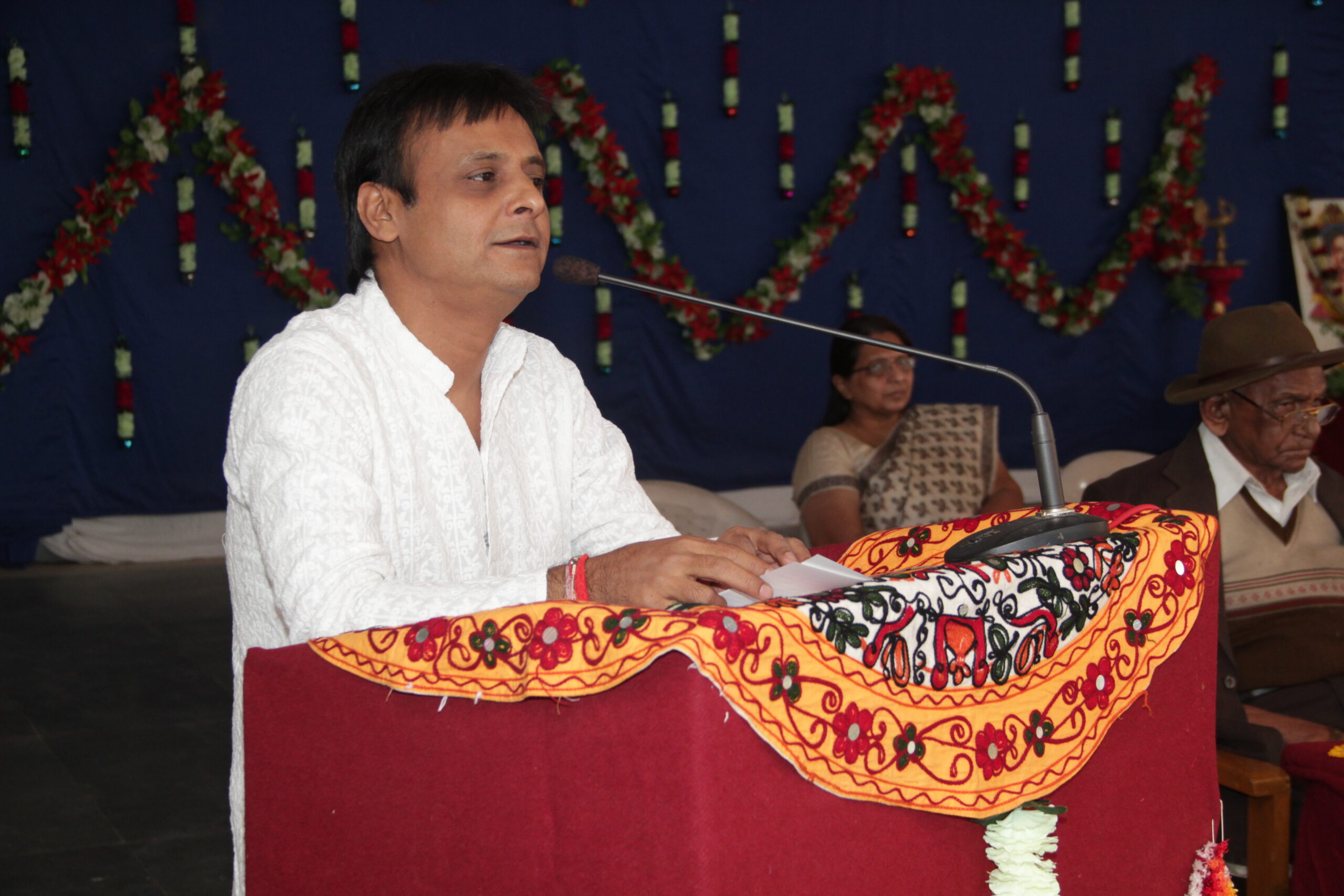
His legacy is built upon championing the rights of farmers, ensuring access to essential social welfare programs, and fostering informed citizenship through democratic education. Rooted in the belief that leadership is about delivering tangible results, the focus is on empowering communities and addressing systemic inequalities through proactive initiatives.
Central to this mission is the “Lok Seva Karyalay,” a testament to the dedication to accessible public service. This initiative simplifies bureaucratic processes, providing a one-stop solution for individuals seeking assistance with government schemes. Guided by the philosophy that “Our land is our mother, and its water is like mother’s milk,” this work strives to create a just and equitable society where every individual has the opportunity to thrive.
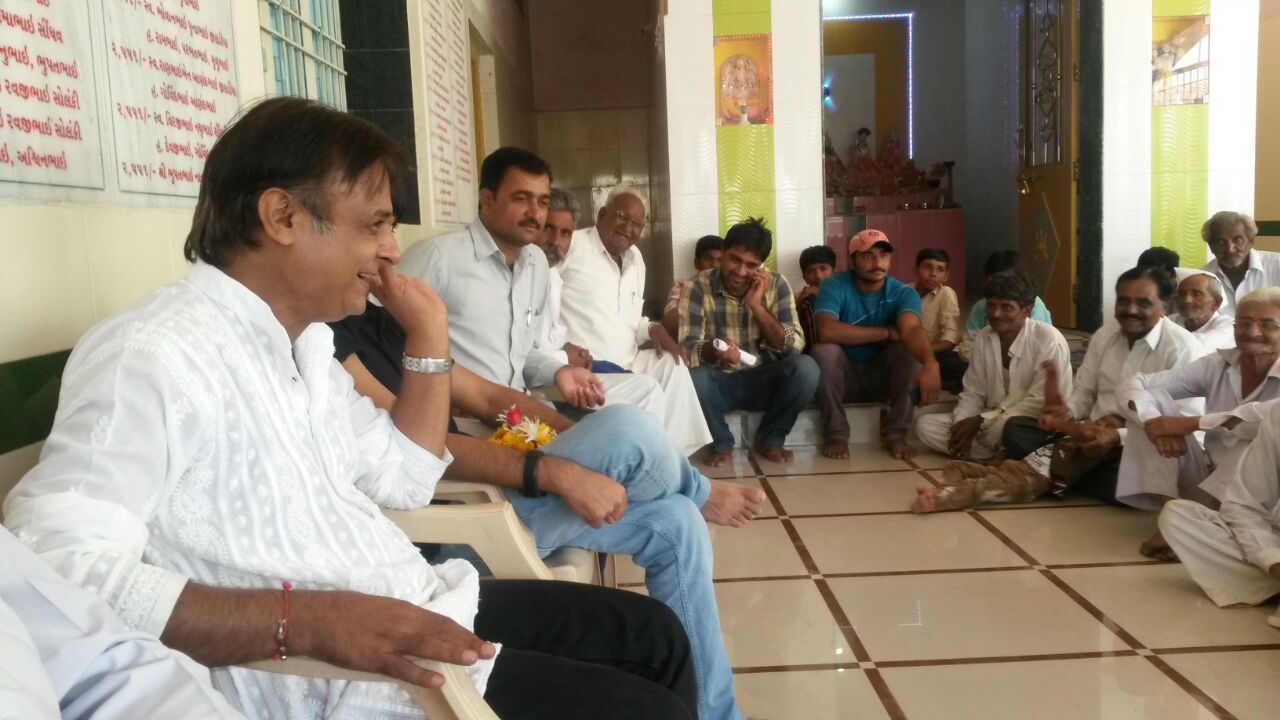
BRIDGE 2 Piplana Jawahar Chavda MLA 85-Manavadar
POLITICIAN SPENDS Final Jawahar Chavda MLA 85-Manavadar
Jawahar Chavda Secures 9.5 Crore Water Grant: Solving farmers' Crisis
Shapur Saradiya Railway: Approved! Thanks to Jawahar Chavda
78.34 + 4.32 Crore: Jawahar Chavda Transforms Vanthli Taluka!
34.6 + 8 Crore: Jawahar Chavda Transforms Manderda Taluka
Manavadar Thanks Jawahar Chavda: Roads, Rivers, Homes & More
The Qualities of a True Leader: Manavadar Citizens Speak
Fighting for Manavadar Farmers: Jawahar Chavda's Crop Insurance Plea
Jawahar Chavda Exposes BPL Neglect: Fighting for the Underprivileged
BPL Holders Thank Jawahar Chavda: Exposing Government Neglect!
Vanthli's Lost Light: Residents Speak on Shutdown Power Project

